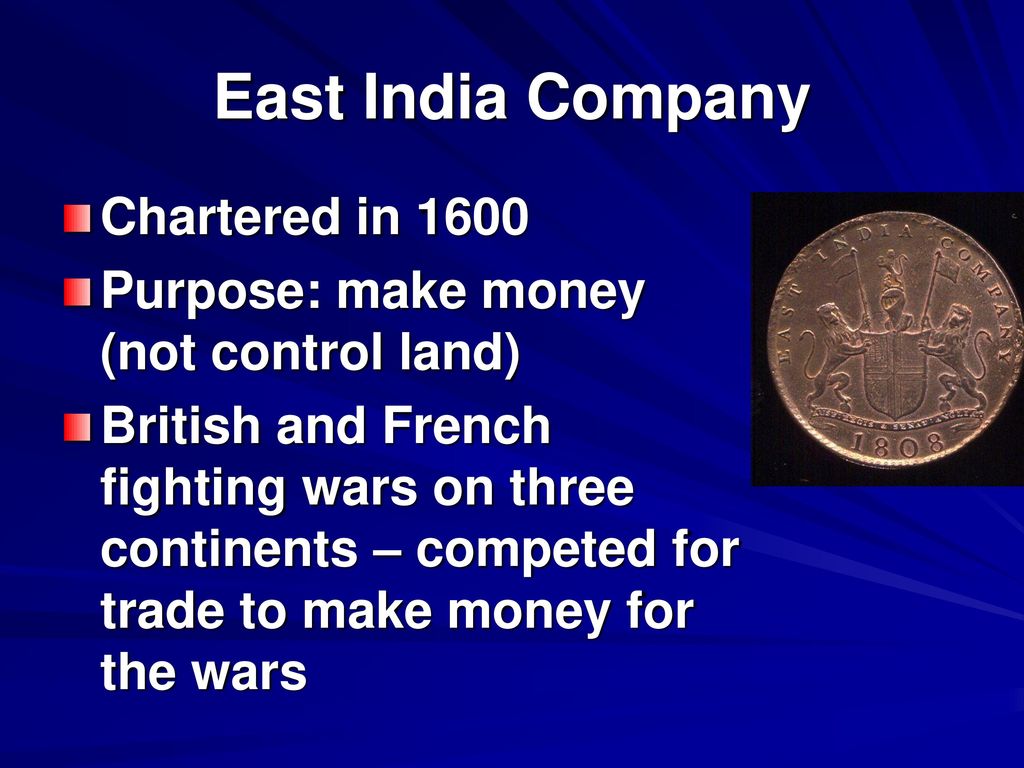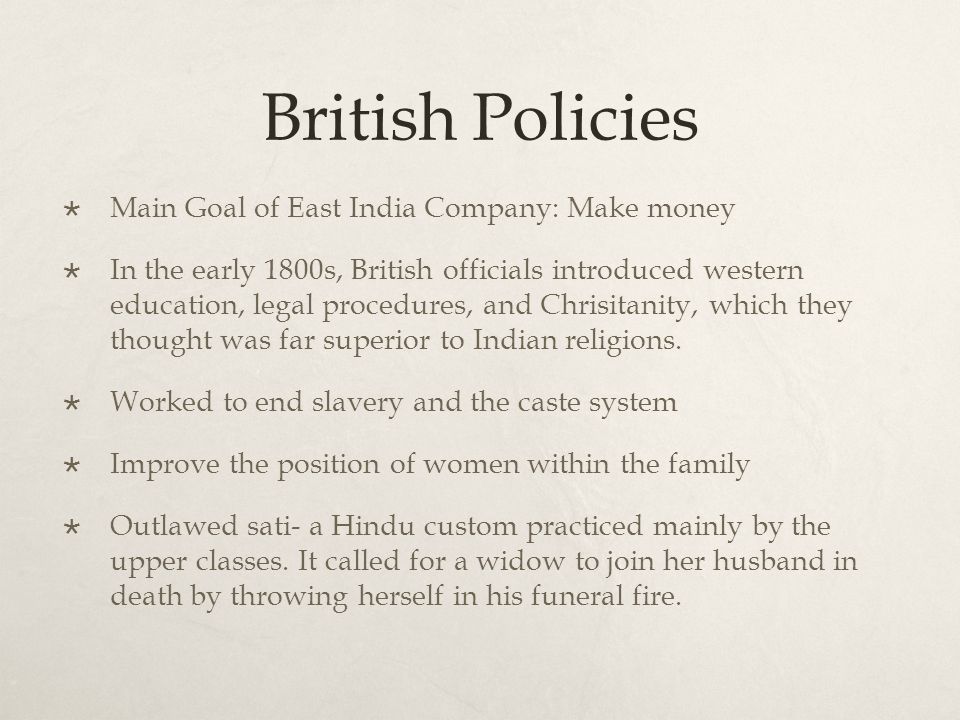
Ina group of London merchants led by Sir Thomas Smythe petitioned Queen Elizabeth I to grant them a royal charter to trade with the countries of the eastern hemisphere. Few could have predicted the seismic shifts in the dynamics of global trade that would follow, nor that years later, the company would pass control of a subcontinent to the British crown. In reality, how did this company gain and consolidate its power and profit? The company had initially planned to try and force their way into the lucrative spice markets of south-east Asia, but infia this trade was already dominated by the Dutch. After EIC merchants were massacred at Amboyna in present day Indonesia inthe company increasingly turned their attention to India. From these coastal toeholds, they orchestrated the profitable trade in spices, textiles and luxury goods on which their commercial success was predicated, omney with Indian artisans and producers primarily through Indian middlemen. The company grew in both east india company how to make money and influence across the 17th and 18th maake. They grappled to maintain their trading privileges in the face of declining central Mughal authority and the emergence of dynamic individual successor states. European competitors also began to have an increased presence on the subcontinent, with France emerging as a major national and imperial rival during the War of Austrian Succession and the Seven Years War. As well as maintaining a large standing army consisting primarily of sepoys Indian mercenary soldiers trained in European military techniquesthe EIC was able to call on British naval power and crown troops garrisoned in India. After military victories at the battles of Plassey and Buxarthe EIC was granted the diwani of Bengal — control over the administration of the region and the right to collect tax revenue.
Trending News
The compaany ended up seizing control of large parts of the Indian subcontinentcolonised parts of Southeast Asiaand colonised Hong Kong after a war ,oney Qing China. Originally chartered as the «Governor and Company of Merchants of London Trading into the East-Indies», [5] [6] the company rose to account for half of the world’s trade, [7] particularly in basic commodities including cottonsilkindigo dyesaltspicessaltpetreteaand opium. The company also ruled the beginnings of the British Empire in India. These Jow companies amalgamated in March into the Dutch East India Company VOCwhich introduced the first permanent joint stock from meaning investment into shares did not need to be returned, but could be traded on a stock exchange. By contrast, wealthy merchants and aristocrats owned the EIC’s shares. During its first century of operation, the focus of the company was trade, not the building of an empire in India. The battles of Plassey and Buxarin which the British defeated the Bengali powers, left the company in control of Bengal with the right to collect revenue, in Bengal and Bihar[12] moneey a major military and political power in India. In the following decades it gradually increased the extent of the territories under its control, controlling the majority of the Indian subcontinent either directly or indirectly via local puppet rulers under the threat of force by its Presidency armiesmuch of which were composed of native Indian sepoys.
The trading firm took command of an entire subcontinent and left behind a legacy that still impacts modern life.
Despite frequent ewst intervention, the company had recurring problems with its finances. It was dissolved in as a result of the East India Stock Dividend Redemption Act passed one year earlier, as the Government of India Act had by then rendered it vestigial, powerless, and obsolete. The official government machinery of British India assumed the East India Company’s governmental functions and absorbed its navy and its armies in Soon after the defeat of the Spanish Armada inthe captured Spanish and Portuguese ocmpany with their cargoes enabled English voyagers to potentially travel the globe in search of riches. Having sailed around Cape Comorin to the Malay Peninsulathey preyed on Spanish and Portuguese east india company how to make money there before returning to England in These riches aroused the Ondia to engage in this opulent commerce. Inthree more English ships sailed east but were noney lost at sea.
The East India Company’s Need for Money:
The East India Company was founded in as a means to secure a trade monopoly in and around the Indian Ocean, partly for the reason of securing the spice trade. The spice trade was highly lucrative. The East India Company needed money to get started because of the expenses involved in sending ships with crews and establishing trade outposts. Become a Study. The company had to secure a royal charter, but upfront costs required early investment. With the granting of the charter, investors could be more confident that they would reap the rewards of the East India Company’s endeavors in the Indian Ocean as there would be no other competition at least within the United Kingdom to harm revenue.

Choose your subscription
Sign in. Accessibility help Skip to navigation Skip to content Skip to footer. Choose your subscription. Not sure which package to choose?
Accessibility Links
Starting as a monopolistic trading body, the company became involved in politics and acted as an agent of British imperialism in India from the early 18th century to the midth century. In addition, the activities of the company in China in the 19th century served as a catalyst for the expansion of British influence there. Incorporated by royal charter on December 31, , it was started as a monopolistic trading body so that England could participate in the East Indian spice trade. It also traded cotton, silk, indigo, saltpeter, and tea and transported slaves. It became involved in politics and acted as an agent of British imperialism in India from the early 18th century to the midth century. From the late 18th century it gradually lost both commercial and political control. In it ceased to exist as a legal entity. The East India Company was initially created in to serve as a trading body for English merchants, specifically to participate in the East Indian spice trade. It later added such items as cotton, silk, indigo, saltpeter, tea, and opium to its wares and also participated in the slave trade.
According to the Oxford English Dictionary, this word was rarely heard outside the plains of north India until the late 18th century, when it suddenly became a common term across Britain. To understand how and why it took root and flourished in so distant a landscape, one need only visit Powis Castle. The last hereditary Welsh prince, Owain Gruffydd ap Gwenwynwyn, built Powis castle as a craggy fort in the 13th century; the estate was his reward for abandoning Wales to the rule of the English monarchy. But its most spectacular treasures date from a much later period of English conquest and appropriation: Powis is go awash with loot from India, room after room of imperial plunder, extracted by gow East India Company in the 18th century. There are more Mughal artefacts stacked in this private house in the Welsh countryside than are on display at any one place in India — even the National Museum in Delhi.
The trading firm took command of an entire subcontinent and left behind a legacy that still impacts modern life.
There are talwars set with yellow topaz, ornaments invia jade and ivory; silken hangings, statues of Hindu gods and coats of elephant armour. Such is the dazzle of these treasures that, as a visitor east india company how to make money summer, I nearly missed the huge framed canvas that explains how they came to be. The picture hangs in the shadows at the top of a dark, oak-panelled staircase. It is not a masterpiece, but it does repay close study. An effete Indian prince, wearing cloth of gold, sits high on his throne under a silken canopy.
Comments
Post a Comment